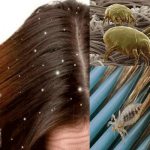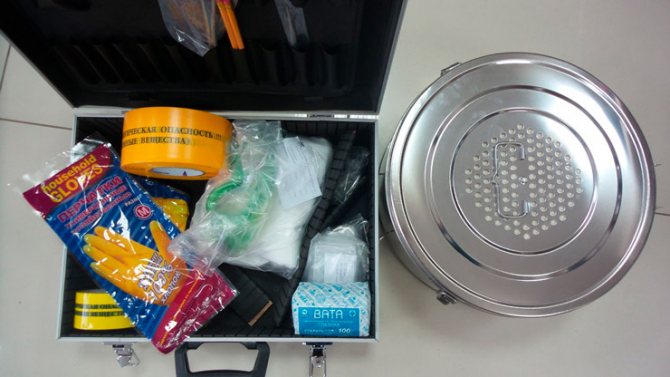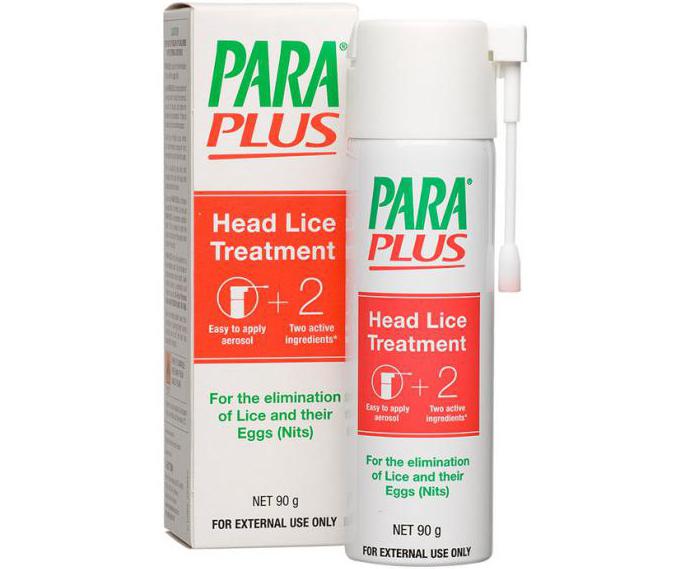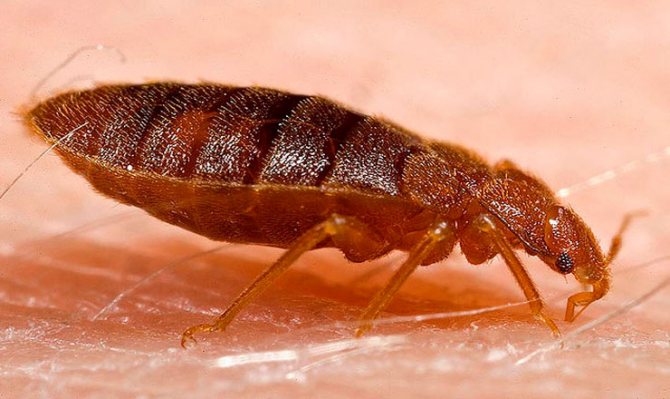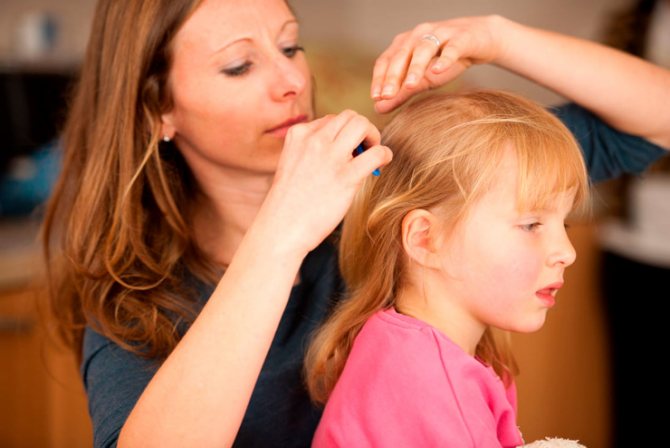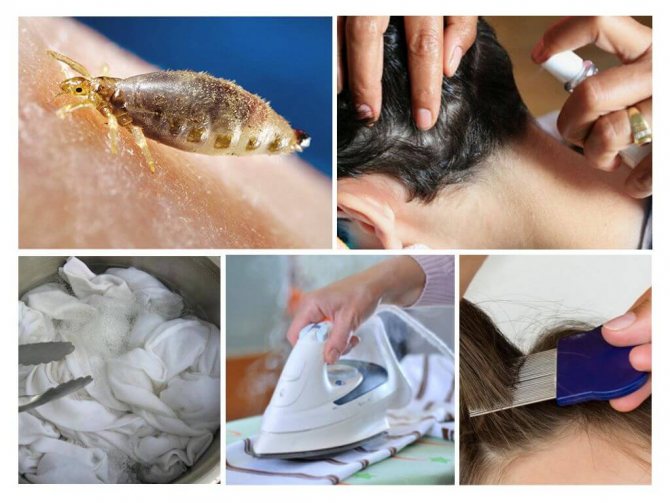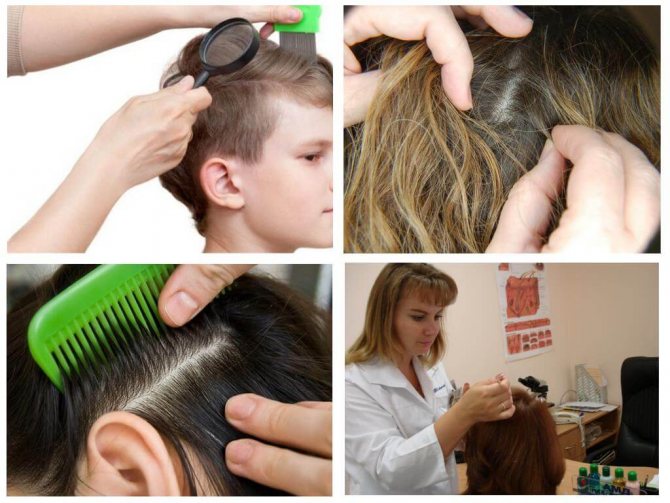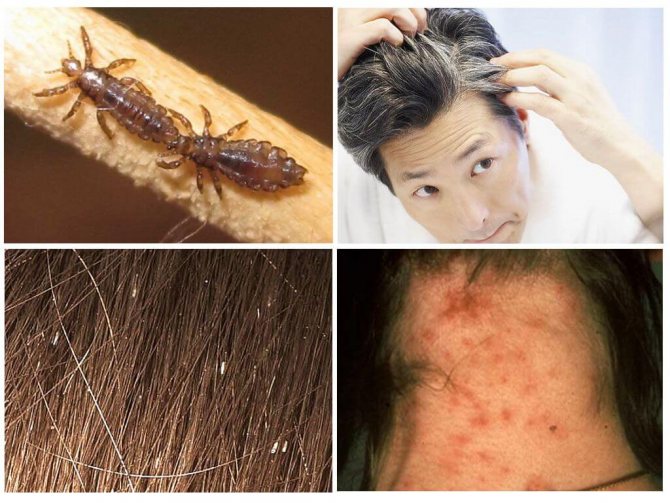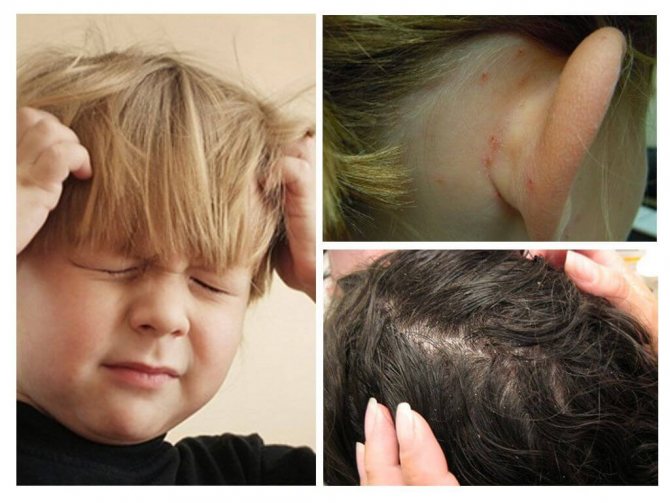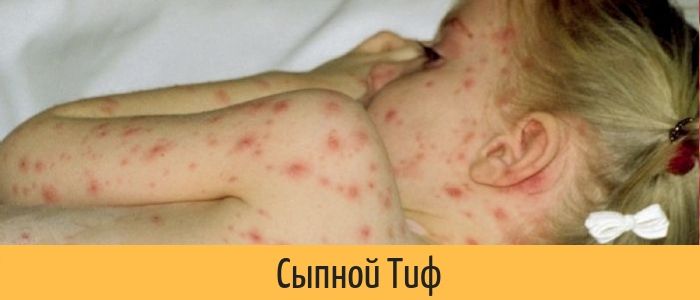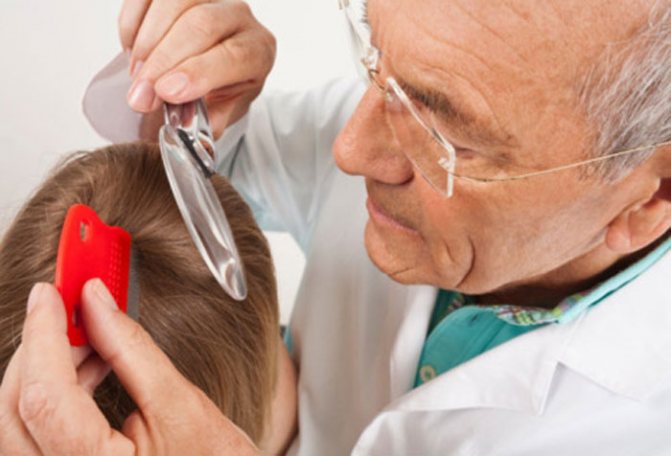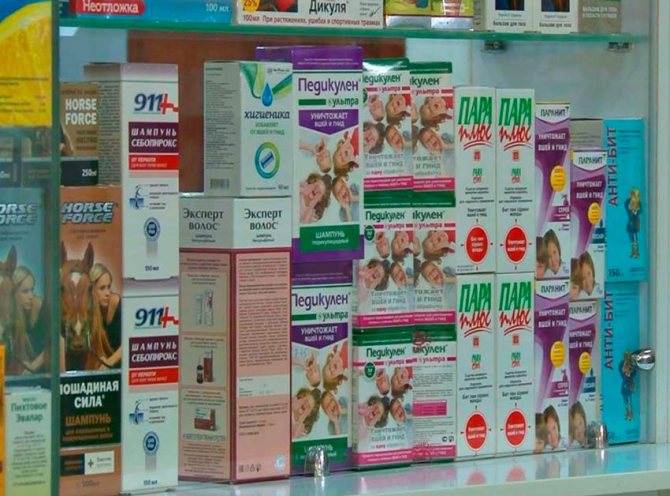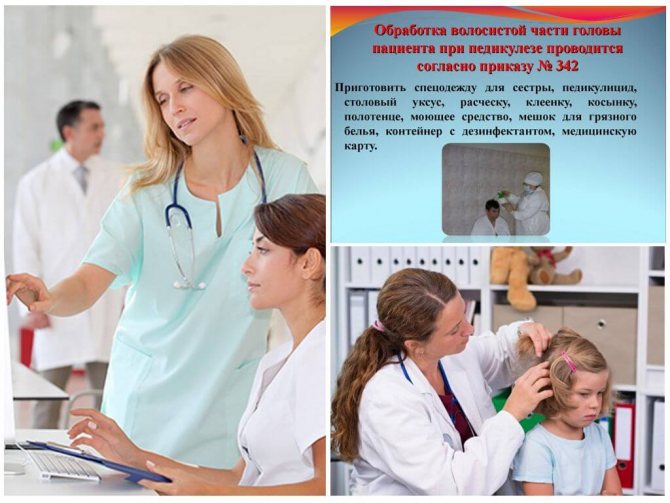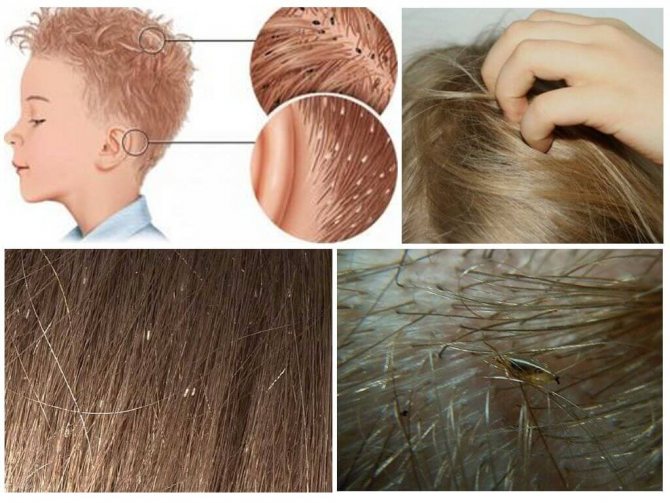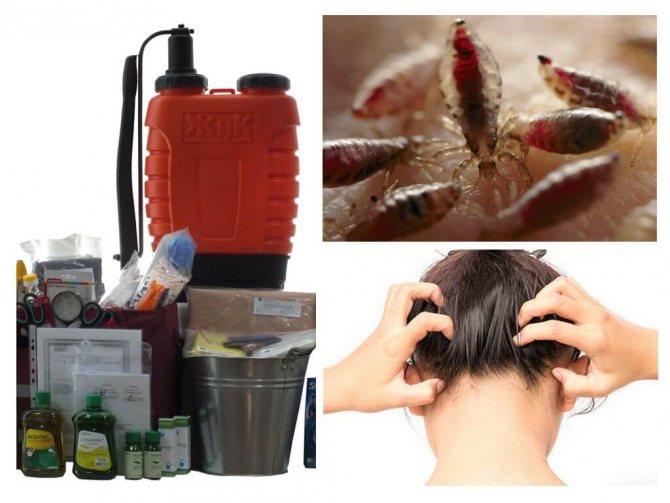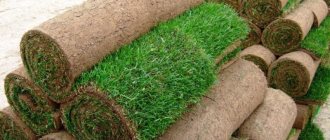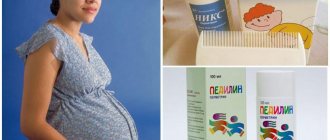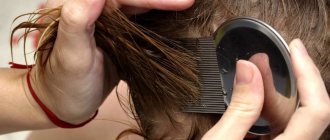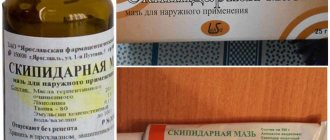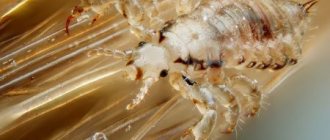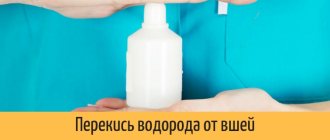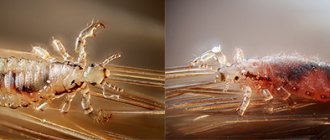Pediculosis is not only an aesthetic problem, but also a disease that must be fought against. For this, doctors treat the patient when head lice is detected. Her main task is to destroy lice and nits, to prevent their spread to other people. Ignoring this issue can have serious consequences, as a lice infestation can cause typhus.
In what cases is processing carried out
Detection of head lice usually occurs in the admission department at the sanitary inspection room. If it was possible to find adult lice and nits in the hair, an additional examination of personal hygiene items and the patient's belongings is carried out. The patient is transferred to a closed room and examined on a couch. The procedure for getting rid of lice is carried out in the inpatient department. Disinsection measures include comprehensive measures to destroy parasites in hair, body, clothing.
Pediculosis
Contraindications for processing may be:
- children under 3 years old;
- pregnancy, lactation;
- serious condition of the patient;
- a large number of purulent wounds on the skin.
If head lice is detected, it is necessary to fill out the appropriate papers, in which the patient gives his permission to carry out the procedure. Preparations for lice are allocated either from the medical fund, or purchased at the expense of the patient. The actions of a nurse in case of head lice are reduced to the preparation and conduct of sanitation, filling out a journal, the data in which is displayed in the form of a table, and notifying the patient's relatives.
In cases of detection of lice in children, the health worker informs the preschool or school institution. According to the new Sanpin for the prevention of head lice, an unscheduled examination is carried out in the class, the group, and preventive measures are taken to prevent the spread of lice.
Briefly about the parasite
Fossilized lice eggs found by scientists are more than 10,000 years old, and head lice has been known since ancient times. The insects themselves are very small, the average size of an adult does not exceed 6.5 mm, and the females are always larger than the males. The outer cover is pale beige to gray, but may be different. The basis of the diet of these parasites is the host's blood.
Lice do not live long - 2-4 weeks, but during this time they manage to give birth to up to 300 offspring units. Nits - the eggs of these insects - are oval in shape, their size does not exceed 1.5 mm, and the color varies from white to yellowish. According to the place of residence on the host's body, as well as external differences, these arthropods are divided into several types:
- Head louse... The insect lives on the human scalp, including the eyebrows, mustache and beard. The life cycle of individuals of this species is approximately 4 weeks, the newly hatched larvae immediately begin to eat. These arthropods are carriers of relapsing fever and typhus.
- Body louse, or body louse... Slightly larger than the previous species, lives in seams and creases on clothes and in linen folds. Life expectancy can be up to one and a half months, the comfortable temperature for these insects on the host's body is 25-30 degrees.
- Smallest representative - pubic louse... Individuals can be found in the armpits, in the space between the eyelashes and on other hairs covering the human body. The life of the parasite is incomparably short and does not exceed 2 weeks on average.
What is anti-lice styling, see the video:
With their small size and constant need for food, lice can live up to two days when fully immersed in water. The reproduction process in these creatures occurs all year round. The saliva of this insect, which is released at the time of the bite, causes a burning sensation and itching in the host, as well as allergic reactions.
Lice examination
Medical workers are obliged to conduct an examination of head lice in preschool educational institutions once a month, at school after holidays, selectively by class every month. At enterprises, institutions, organizations, mandatory examinations should also be carried out twice a year.
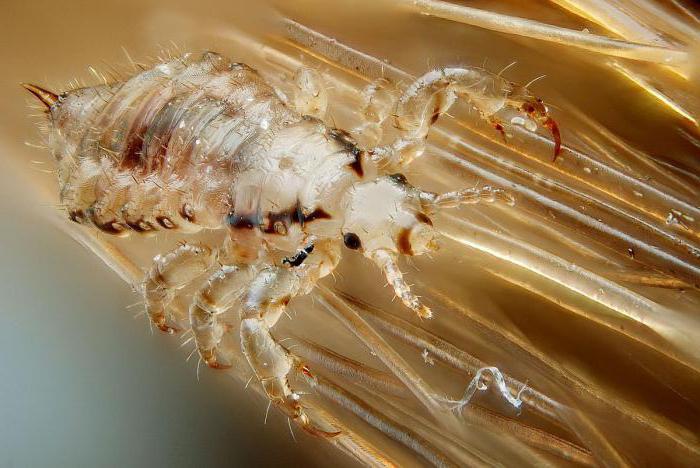
According to the order of the Ministry of Health, a preventive examination of patients at the sanitary inspection room is mandatory when a patient is placed for inpatient treatment or in a maternity hospital. The inspection procedure involves the use of a comb with frequent teeth, a magnifying glass, or a loupe.
Basic Provisions
The news about the change in the legislation on the prevention of lice instantly spread throughout Russia. The order is to read immediately so that you know how to act in a given situation. The sanitary rules for head lice describe the actions that health workers must take to prevent an epidemic of the disease and prevent:
- examinations of the population for prevention are carried out according to a plan approved by the higher authorities;
- all preschool educational institutions, kindergartens, orphanages, sanatoriums, rest homes, stationary organizations, the purpose of which is to maintain the health of the child, are provided with detergents, disinsection, for personal hygiene;
- first-aid posts, other organizations that deal with the treatment of pediculosis, disinsection of premises, things, provide special equipment, technique, means;
How processing is carried out
Sanitation is carried out in a separate room. It should be well ventilated. The nurse's tactics when performing disinsection is predetermined by the degree of infection of the patient, and therefore a treatment scheme for the patient is prescribed. Preparatory work involves a number of activities:
- cover the couch with oilcloth material and seat or lay the patient on it, after putting on a perlin and a tourniquet around the hairline;
- explain to the patient the process of the upcoming manipulation;
- the medical worker performing the procedure must put on an additional gown, gloves, a mask and prepare all the necessary equipment: an anti-pediculosis agent, hair clippers, a basin in 2 copies, bags for disposal and subsequent disinfection, a comb, vinegar.
Anti-lice treatment
Treatment algorithm for head lice:
- Prepare a solution for the destruction of parasites according to the instructions.
- Consistently treat hair from lice, avoiding contact with mucous membranes, face. Each strand should be processed separately.
- If the hair is long, collect it in a bun and cover it with a plastic kerchief.
- Maintain exposure according to the manufacturer's recommendations.
- After the specified time has elapsed, wash off the product with warm water, after removing the remnants of the drug, wash your hair with a washing shampoo and rinse with a vinegar solution.
- After applying the vinegar solution, tie the hair with a plastic kerchief, leave it in this state for 15-20 minutes.
- Rinse hair again with warm water and towel dry.
- Place the patient on a chair, spread paper on the floor, so that later it will be easier to dispose of insects. Be sure to comb out dead insects and nits with a fine-toothed comb.
- Periodically remove adhering parasites from the crest with a cotton swab dipped in alcohol.
- At the end of the procedure, re-examine the patient and make sure that there are no lice and nits.
- If necessary, re-treatment of hair with head lice is prescribed.
Remedies for head lice
The main substances for the extermination of insects are ovicides (emulsions, shampoos, lotions) for a single treatment and neovicides (shampoos, soap, etc.) - for a double treatment.
To combat parasites, agents such as vinegar, pyrethrum powder, tar soap, and various lotions, such as Nittifor, are used.
The list of preparations intended for disinsection of things includes a soap-kerosene emulsion, concentrates of karbofos, sulfidos, sodium carbonate and others.
Features of anti-lice styling
Pediculosis infection is the presence of insects in different areas of the human body or clothing, and is a parasitic disease. Their presence on the head is considered the most problematic. We will now talk specifically about head lice.
We suggest that you familiarize yourself with: A dream about lice in my head why
Outbreaks of head lice and exceeding the epidemic threshold were noted in some regions and republics of the Russian Federation, and the spread of body lice, which often became carriers of infectious diseases such as typhus and Brill's disease, was of great concern.
The greatest danger in the event of an epidemic is body lice, which, after consuming the patient's blood, are capable of becoming carriers within 5-7 days and transmitting the infection to healthy people.
The causative agents of these diseases are found in the stomach and stool of the lice. Human infection occurs when the secretions of an infected louse get into wounds and scratching places on the body:
- in order to prevent the appearance and further spread of lice, a set of hygienic measures is recommended, which includes washing the body every 1-1.5 weeks, periodically changing linen if it is dirty, regularly cutting hair and washing underwear and outerwear;
- if parasites are found, then their destruction must be carried out on the body of the sick person, and on his clothes, and bed linen;
- if the number of insects is small, then it is possible to carry out their mechanical destruction, that is, comb out lice and nits with a comb or cut the hair, all collected parasites and hair are collected on paper, and then burned;
- if lice and larvae are found on the body, disinfection and sanitization are performed, including washing with hot water and soap and a complete change of linen;
- to destroy body lice, it is recommended to use pediculicides or boiling linen, as well as ironing all seams and folds with an iron;
- in hospitals, boarding schools, children's institutions, processing is carried out by medical personnel;
- at home, the destruction of lice is carried out by residents under the control of the departments of the sanitary and epidemiological station;
- to combat head lice, it is recommended to use insecticidal preparations and subsequent rinsing with 5% acetic acid solution;
- it is forbidden to do treatment with pediculicides for children under 5 years old, pregnant and lactating women, as well as people with skin diseases;
- underwear, bed linen, clothes are soaked in water with the addition of special disinfectants.
The head louse feeds on the blood of the human scalp and therefore can live on it. This parasite is a blood-sucking insect, and in the process of life it lays eggs. A person can get head lice as a result of non-compliance with the rules of systematic hygiene, or coming into contact with those people who have insects in their heads.
Contact with animals cannot lead to infestation with head lice, because human lice cannot live and reproduce on their wool.Note the fact that after infection, some time passes before the first symptoms appear, two weeks or more.
For this reason, you will not immediately notice the parasites in your head, even if you become infected with them.
To destroy insects, anti-lice work is carried out in public places, for which special anti-lice styling will be required. We will consider its composition later.
After two or more weeks from the moment of infection, the lice infection begins to manifest itself, and its symptoms become noticeable. The most obvious symptom is severe itching on the head, in the area where there are insects. Over time, small swelling and sores form there, which are combed when itching.
Paying attention to the scalp, you will notice bite points on it that look like a prick. A little later, small light spots become apparent. In the region of the back of the head, temples and near the ears, peeling is noted, which later become wet.
The insects themselves, very small, barely visible to the eye, will be indisputable evidence of infestation with head lice.
Then you will see the so-called nits, that is, the eggs of the lice glued to the hair near the roots. To combat head lice, an anti-lice styling has been developed, which allows sanitizing and destroying foci of infestation with head lice.
We suggest you familiarize yourself with: Crickets in the garden: what to do and how to get rid of
This styling exists in various modifications, but it is always made out in a set and meets the highest requirements for the destruction of infection. Next, we will list all those elements that make up its composition, but for now let's talk about preventive measures.
The fact is that it is very difficult to remove head lice, so it is best to keep them out.
The fight against head lice in the order provides for the following exterminatory and preventive measures:
- Recommendations for doctors and medical workers of medical and prophylactic institutions on the timely identification of patients with typhoid or those who are suspected of having this disease.
- It is obligatory to submit reports on morbidity statistics every month and year.
- When an epidemic focus is detected in the area of residence, rest and work of the patient, mandatory disinfection of the premises is carried out, and all places where the patient was in the last 21 days (incubation period) are taken into account.
- The contacts of the sick person are identified, the belonging of his belongings, and he himself is subject to hospitalization at the local infectious diseases hospital for examination and treatment.
- When head lice is detected, special medical and disinsection measures are taken.
- All things must be processed in a disinfection chamber.
- Blood tests are taken from all people who have come into contact with the patient, serological diagnostics are carried out in a special laboratory to identify cases, and in the future it is necessary to monitor their condition.
- All data are entered into the outbreak survey card, which is then processed and registered with a special body dealing with especially dangerous infections of the State Sanitary and Epidemiological Surveillance in this region of Russia.
A person is susceptible to parasitism of 3 types of lice: head, clothing and pubic. The first 2 species are carriers of such infectious agents as typhus and relapsing fever, Volyn fever.
Kit Contents
And now we will consider the composition, in accordance with which a set of drugs and things for the destruction of head lice is formed. Anti-lice styling without fail contains:
- a bag for putting things of an infected person into it, most often it is a cloth bag or sack;
- a container for holding hair that is being cut. In it, a tourniquet is either performed disinfection with chemicals;
- protective cut from oilcloth;
- disposable gloves;
- large or small scissors;
- comb with fine teeth;
- hair clipper;
- glass spirit lamp;
- cap completely made of polyethylene, disposable;
- sterile cotton wool, vinegar;
- a chemical agent against lice;
- shampoo;
- means for disinfecting rooms and bed linen;
- aerosol sprayer, disposable gown;
- composition, that is, a list of products that make up the styling;
- packing bag.
This anti-lice styling has such a composition that will make possible the whole range of measures to combat head lice. Pediculosis is caused by several types of parasites - head lice, body lice, pubic lice.
According to the documentation, the first 2 types of parasites are carriers of typhus, relapsing fever, Volyn fever.
The Ministry of Health includes a set of measures aimed at improving sanitary and hygienic conditions, the epidemiological situation in public institutions and organizations. As well as specific measures for the treatment of head lice in infected individuals.
The order for head lice gives guidelines for the detection, prevention, treatment. The organization and implementation of measures to combat head lice is carried out by medical workers. Many are worried about the fight against parasites that have already struck a person.
The modern composition of the anti-lice packing is as follows:
- Bag for collecting the patient's belongings: cotton or oilcloth.
- A galvanized tray or bucket where hair will be disinfected.
- Oilcloth bed for manipulation.
- Latex gloves.
- Frequent metal comb.
- Scissors and / or hair clipper.
- Alcohol lamp.
- 2-3 kerchiefs.
- Disposable gown.
- Cotton pads.
- Table vinegar.
- The main elements in the composition of anti-lice styling are means of destroying pubic and head lice:
- Ovicides for one-time treatment: shampoos, lotions, emulsion concentrates, etc.
- Neovicides (agents with incomplete ovicidal action) for 2-fold treatment within a week to ten days. These are special soaps, shampoos and other products.
- Products that destroy body lice: ovicides and neovicides.
- Aerosols and a number of other agents that are used for disinfestation of premises.
- vinegar solution;
- 20% benzyl benzonate emulsion;
- pyrethrum powder;
- 5% boric ointment;
- 0.15% karbofos solution;
- dust or tar soap;
- "Medifox";
- lotion "Nytilon", "Lontsid", "Nittifor";
- soda ash;
- "Medifox-Super";
- 50% concentrate of sulfidos, karbofos;
- 20% water-kerosene-soap emulsion.
We suggest that you familiarize yourself with: Paranit Sensitive from lice and nits: instructions, reviews
When using insecticidal products, you need to protect the skin. Carry out the treatment in rubber gloves, put a bandage on the patient's forehead. Make sure that the product does not get into the mouth, nose, eyes. In case of contact with mucous membranes, wash off the drug with running water.
Before using any drug, you need to test for individual intolerance. The minimum amount of the product is applied to the elbow bend, left for 1 hour. The appearance of red spots, irritation, rashes, itching, burning, is the basis for refusal to use.
As part of the styling, the following tools are effective:
Appendix No. 4 to this order prescribes the following measures to prevent the spread of lice:
- Periodic bathing with obligatory shampooing - at least once every 10 days.
- Change of a set of bed linen - at least twice a month.
- Systematic washing of clothes, personal items as they become dirty, followed by processing with an iron with the "steam" function.
- Daily hair combing, haircut as needed.
- Cleaning of items of outerwear, compliance with the rules for its storage.
- Periodic wet cleaning in the house.
- Keeping your home clean.


Anti-lice styling
Justification for issuing an order
The release of the order was justified by the massive spread of head lice in Russia, when the country recorded an annual incidence rate of up to 300 thousand people, and 75% of these cases were registered in children's institutions. A large number of patients were identified during hospitalization in medical institutions.
Outbreaks of head lice and exceeding the epidemic threshold were noted in some regions and republics of the Russian Federation, and the spread of body lice, which often became carriers of infectious diseases such as typhus and Brill's disease, was of great concern. According to the observations of doctors, a large number of patients were carriers of several types of lice at once: for example, 80% of the surveyed homeless people were found to be simultaneously affected by hair and body lice.
In Russia, in contrast to developed European countries, where typhus is not even mentioned, dozens of cases of this disease are recorded annually, and in some regions about 100 patients with a recurrent form of Brill's disease are diagnosed annually.
There is a tendency for typhoid diagnostics not to be carried out on time and many patients are hospitalized by mistake with other diseases, and typhoid symptoms are not detected. Often, a person's feverish condition or rash has been identified by doctors as an allergic reaction, meningitis, or other similar illness. This happens as a result of insufficient professional training of doctors and staff, shortcomings in the analysis and research.
The final stage
Completion of the procedure:
- burn the paper over which the combing was carried out;
- take off the patient's clothes, underwear and put them in an oilcloth bag, carry out the same manipulations with the nurse's clothes, who was involved in the treatment;
- send the bags to the disinfecting chamber;
- treat the comb with alcohol;
- carry out the treatment of the premises with an insecticidal preparation.
At the end of the procedure, the nurse must fill out the head lice examination log, make an appropriate note in the patient's outpatient card. Re-examination is carried out after 7 days, if necessary, additional processing is performed.
In cases of detection of body lice, hygiene procedures are prescribed, and all the patient's belongings are subject to heat treatment. It is recommended to sanitize the apartment. After the parasites are removed, the medical worker conducts explanatory conversations so that the patient cannot get sick with head lice again.
Procedure execution
The patient's hair is processed. For this, anti-lice preparations are used that are part of the styling. After that, a hat is put on the head. After 20 minutes, the curls are washed with the shampoo from the set. The dried hair is combed with a fine comb, strand by strand. Completion of the procedure involves the following steps:
- Personal belongings of the patient are put in bags for disinfection.
- All instruments used for the procedure (gloves, apron, gown) are placed in a bag.
- The patient's hair is re-examined.
- After each examination, the comb is poured with boiling water or treated with alcohol.
We suggest that you familiarize yourself with: How to get rid of black strigu beetles in the garden
After the disinfection, for which the anti-lice styling was used, is over, the room and objects previously used by a person infected with lice are treated with special preparations.
Algorithm of actions


Algorithm of actions for head lice
Head lice styling begins with preparatory procedures. The room must be well ventilated. A tourniquet from a scarf is tied on the patient's head along the hairline to prevent the product from getting on the skin and eyes.
Put on a dressing gown, rubber gloves, prepare a solution according to the instructions. Put the oilcloth on the patient. The hair is distributed into strands.
- Treat the hair with an anti-lice drug.
- Long hair should be styled in a bun.
- A special plastic cap is put on top.
- Withstand the time specified in the instructions.
- Wash off with plenty of water, use shampoo.
- Dilute vinegar, rinse hair, put on a hat again, leave for 15 minutes.
- Rinse again.
- Dry with a towel.
- Combing out dead lice and nits. It is advisable to use a special comb for these purposes.
- Check hair after styling.
Re-examination is carried out in a week. After 14 days, it is recommended to repeat the procedure to consolidate the result. The linen is subject to thermal and chemical treatment.
General cleaning of the treatment room
General cleaning is carried out once a week according to the schedule. The date of cleaning is recorded in a log kept at the workplace or by the head nurse.
The head nurse supervises the general cleaning.
The office room is freed from objects, equipment, inventory, tools, medicines. As des. funds are used:
1% solution of activated chloramine (100 g. Chloramine per 10 liters of water + 40 g. 10% ammonia);
5% solution of chloramine (500 gr. Chloramine per 10 liters of water);
6% solution of hydrogen peroxide with 0.5% detergent solution;
1%, 3% solution of amocide.
Consumption rate - 200 ml des. funds for 1 m 3 of the room and 100 ml for 1 m 2 of furniture.
Staff requirements for general cleaning:
put on a scarf that completely covers the hair, a dressing gown, a respirator (mask), canned glasses, gloves, rubber boots, an oilcloth apron.
General cleaning process:
Disinfectants are applied to walls, windows, doors by wiping or sprinkling, and a bactericidal irradiator is turned on for 60 minutes. Then all surfaces are rinsed with an autoclaved rag with clean tap water using 2 brushes (one labeled “for walls”, the other “for floors”).
Disinfected items are brought into the office and the bactericidal irradiator is turned on again for 60 minutes. The room is ventilated.
Application for goods
| Price 4500 rubles |
Pedicular styling is intended for anti-lice treatments. It includes a set of necessary things and preparations needed to identify and destroy lice.
Scope of styling with pediculocidal agents: - medical offices of educational institutions, including school and preschool age - children's homes and boarding schools - hospitals, clinics - sanatoriums, children's camps - social services
Mode of application
Every hospital should have a lice-proof packing to kill parasites. Also, it is necessary for every medical institution to lay down for examination for head lice. It is designed for the timely detection of lice and nits. It contains rubber gloves, a magnifying glass, a table lamp, a comb and a disinfecting solution for the comb.
Did you know? Parasites are very dangerous - these harmless creatures have been proven to provoke cancer! Few people know, but getting rid of it is very simple - take read more.
Preparation
Having found parasites in a person, the medical professional must follow his job descriptions. They indicate the following sequence of actions:
- Registration in the corresponding document (magazine No. 60).
- Sending a message about a parasitic disease at the patient's place of residence.
- Record in the medical history card.
- Lice extermination. Sanitization is carried out for head lice, as well as actions aimed at cleaning the patient's belongings and the premises where he was.
Before the treatment process, the doctor asks the infected person about the presence of contraindications to the event. These include: pregnancy, breastfeeding, under 5 years of age, skin diseases. The healthcare provider must respect patient rights and confidentiality.For the process of destroying lice in a medical facility, there must be a special ventilated room.
After filling out the documentation and talking with the infected, they begin the preparatory stage of processing. The specialist puts on a disposable gown, rubber gloves, and a scarf. The patient sits on a chair and is covered with an oilcloth. It is necessary to give the person a towel to protect the eyes from the anti-lice remedy.
Pay attention! We beg you, do not delay the removal of parasites, then it will only get worse To clean the history of Dvornichenko Victoria >>
Carrying out disinsection measures
Disinsection measures are divided into 2 sets of actions: the extermination of parasites and the prevention of the disease. The procedure for getting rid of lice using a special styling includes the following actions:
- Hair treatment with a head lice remedy, according to his instructions. For example, "Nittifor" is applied to damp hair, covered with a scarf and a towel. Leave the emulsion on the head for about 40 minutes.
- Washing hair in warm water. After that, shampoo is applied. After washing it off, wipe the head with a towel.
- Hair treatment with 6% warm vinegar solution. You need to cover your head with a scarf and a towel again for 20 minutes.
- Rinse off the vinegar with warm water. For this, the head is dried.
- Disinfection of the comb with vinegar. With a comb, divide the hair into strands, comb out each strand. Before that, you need to put light paper under your hair for dead parasites.
- If the patient agrees to cut the hair, then this is done over the pelvis, from which the hair is then burned.
- Examine hair for remaining lice and nits.
Prevention measures
The prevention of head lice is the use of complex measures in the fight against the spread of this disease. The first thing to do to identify infected children or adults is to carefully examine the scalp. If parasites are found, it is necessary to immediately begin treatment in accordance with the decree of the chief sanitary doctor of the Russian Federation. After recovery, do not forget about the prevention of head lice.
Preventive measures
Contact persons are also examined and, in the absence of parasites, are registered for 1 month with mandatory examinations every ten days.
If infected pubic lice are found, they are sent to a dermatovenerologic dispensary located in their territory.
To prevent the uncontrolled spread of parasites, certain hygienic measures are taken. These measures contain insect contamination of the surrounding area and include:
- obligatory and regular body washing;
- change of linen and bed every 7-10 days;
- haircut
- using only your personal comb for hair care;
- washing clothes, bedding
- regular cleaning of the house, all rooms and surrounding areas;
- constant maintenance of cleanliness of all surrounding furnishings.
In an age of tremendous speeds, sensational discoveries in medicine, it is very offensive to realize that the problem of head lice is still relevant in schools, kindergartens, hospitals, and emigration centers. To achieve success in the prevention of diseases caused by parasites, it is necessary to conduct mass information events in preschool, school and vocational schools.
It is necessary to tell the younger generation about the danger that lies in such seemingly small and harmless insects, like lice are transmitted. Print thematic brochures, information sheets, conduct training activities on prevention, which visually show what lice look like and how they can and should be dealt with.
The order of the Ministry of Health of the Russian Federation on head lice contains Appendix No. 4. It contains methods for the prevention and control of lice. Head lice order number 342 from 26.11. 1998 year
Disease prevention
Prevention of head lice consists in obtaining information, observing basic rules of hygiene, behavior in public places.
Lice are spread from a sick person by close contact when hair touches. And also through infected things, bed, hats, combs. After returning from public places, spending the night not in your own bed, it is recommended to throw things in the wash, wash your hair with shampoo with the addition of tea tree essential oil.
Pediculosis is not really a disease. So called human infection with lice - blood-sucking parasites that feed and reproduce, settling in the hairy areas of the human body. It is easy to get lice from another person, therefore children who do not yet keep their distance from each other during joint games often become their victims. So that everyone can quickly and correctly get rid of parasites without having time to transfer them further, there is an anti-lice styling.
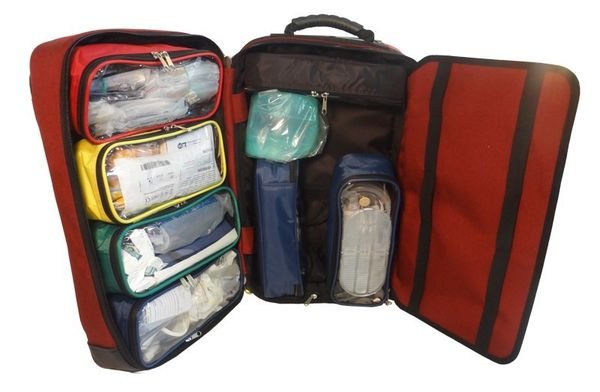

Classic and modern line-up - is there a difference?
Anti-lice styling has not always been the same - medical and sanitary standards are changing, as well as the safety conditions for medical workers. In the classic version, there were some drugs (ovicides and neovicides, for example), which, according to modern standards, are dangerous or undesirable for use on the skin, especially children.


Also in the modern version, more attention is paid to the individual protection of the health worker who performed the disinfestation - there are more protective elements in the packing... They also took care of a waste bag - previously, hair and clothes, if they were also contaminated, were simply processed, folded into a cotton bag and thrown away.
Disease spread
Pediculosis is caused by several types of parasites:
According to the documentation, the first 2 types of parasites are carriers of typhus, relapsing fever, Volyn fever.
The causative agent of the disease enters the digestive tract of an insect through infected human blood. Abnormal cells do not harm lice, are contained in their bodies until the end of their lives, but are not transmitted by females to a new generation.
The virus enters the human skin with the feces of an insect, infection occurs through wounds. On clothing, the infection persists for up to 3 months. In this way, typhus, Volyn fever is transmitted.
The likelihood of infection increases significantly and almost always leads to an acute development of the disease when insects are crushed. Infected blood of parasites enters the human body directly through wounds, scratches.
Pubic lice in humans only provoke severe itching, sores on the skin. Do not entail other dangerous diseases.
The incubation period for head lice is 10-14 days. During this time, a new generation of lice appears. The increasing itching causes inconvenience, attracts attention. Given the rapid multiplication of lice, by the end of the month after infection, a whole population of parasites lives on the head.

